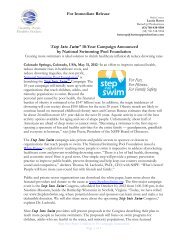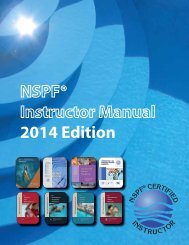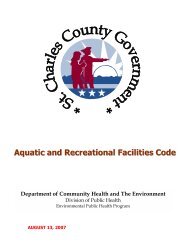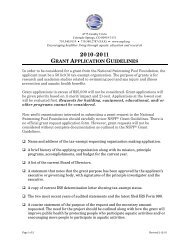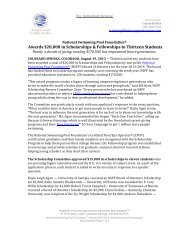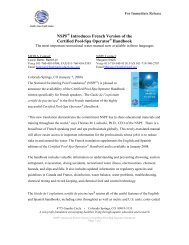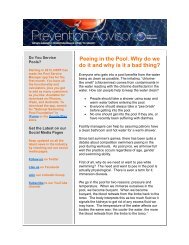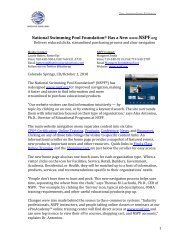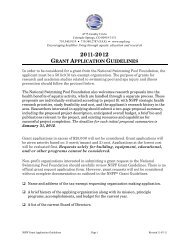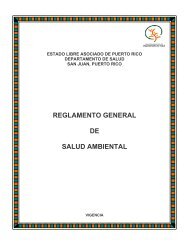English Instructor Manual (PDF) - Metric Version - National ...
English Instructor Manual (PDF) - Metric Version - National ...
English Instructor Manual (PDF) - Metric Version - National ...
You also want an ePaper? Increase the reach of your titles
YUMPU automatically turns print PDFs into web optimized ePapers that Google loves.
NO PRODUCT LABEL CHEMICAL ADJUSTMENT<br />
Amount of Chemical<br />
(from Appendix B-2 or<br />
product label)<br />
Actual Pool<br />
Volume in Gallons<br />
Desired<br />
Chemical Change<br />
Total<br />
160,000 Litres<br />
2 mg/L<br />
÷ 40,000 Litres<br />
(From appendix B-2<br />
or product label)<br />
1<br />
÷ mg/L<br />
(From appendix B-2<br />
or product label)<br />
330 mL<br />
(from product label)<br />
X X 2 =<br />
4 2,640 mL<br />
Conversion: 2,640 mL ÷ 1,000 = 2.64 litres<br />
Key Points: Briefl y discuss free chlorine, total chlorine and combined chlorine. Include a<br />
discussion on how to reduce or prevent organic chloramines that includes the options of:<br />
Water replacement, breakpoint chlorination (BPC), ultraviolet (UV)<br />
Ozone, potassium monopersulfate and indoor air handling<br />
Activity: Work the students through breakpoint chlorination chemical adjustment. Use the<br />
following data: 208,000 litre pool with a FC = 1.5 mg/L, a TC of 2.3 mg/L and a pH of 7.4. Facility<br />
uses calcium hypochlorite. Emphasize that the desired changes is a result of CC x 10 minus<br />
existing free chlorine value. (see example on page 75 of the Pool & Spa Operator Handbook).<br />
Use the same Chemical Adjustment Worksheet to perform the breakpoint chlorination calculation.<br />
(There are several more sample calculations in the Pool Math Workbook that may also be used.)<br />
Key Points: Discuss the source of minerals in pool water and their effect on pool water when they<br />
are oxidized. Include:<br />
Source of minerals such as fi ll water, inadvertent additions of lawn and landscaping<br />
chemicals, algicides, and corrosion due to poor pool water chemistry<br />
Cause of green, red, brown or black water and methods of correction<br />
Key Points: Discuss other commonly used chemicals and their possible effect on pool water.<br />
These include:<br />
Algaecides – Used to eliminate algae from pool water. The most common algaecide<br />
compounds include quaternary algaecides, polymeric algaecides, and metallic (copper)<br />
algaecides.<br />
Stain removers – Chelating agents bond the metals into larger compounds that can be<br />
removed through fi ltration. Sequestering agents remove metals by dissolving them into<br />
solution.<br />
Water clarifiers are used to clear cloudy water. Emphasize that this is a temporary<br />
solution to a bigger problem, usually poor fi ltration.<br />
© 2014 <strong>National</strong> Swimming Pool Foundation® Page 63



